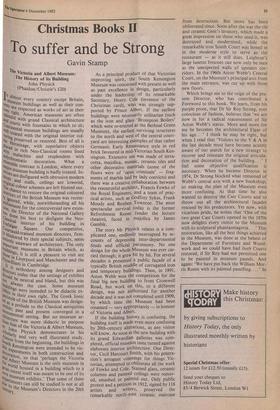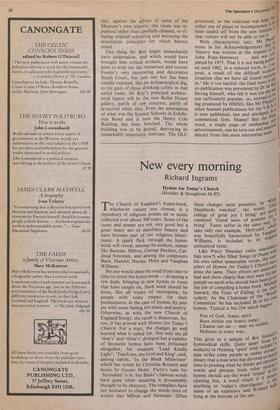Christmas Books II To suffer and be Strong
Gavin Stamp
The Victoria and Albert Museum: The History of its Building John Physick (Phaidon/Christie's £20)
In alMost every country except Britain, tenin, useinn buildings as well as their con- ew's are respected as works of art in their sph,r1„ght. American museums are often
"`-nd with grand Classical architecture
c " courts with fountains in which to sit; %,111,tinental museum buildings are usually 1 treated with the original interior col- the Preserved or restored. Best of all is DI Hermitage, with superlative objects with in rich Neo-Classical rooms lined Malachite and resplendent with Ychrornatic decoration. What a tuserable contrast is London, where every tenor museum building is badly treated. In- st.: lors are disfigured with obtrusive modern 0:13,s and stalls, ceilings are lowered, filginal colour schemes are left blotted out. jete chance to restore the original coloured iy`e.riors of the British Museum was recent- I nthugnored while, notwithstanding all his e...
blasr for the controversial new exten- iasthe Director of the National Gallery
ci adone his best to disfigure the Neo- Trasfs,iical interior of his building in Co-glar Square. Our competitive, lyttauld-trained museum directors, firm- ent.linkered by their special subjects, seem irulrelY unaware of architecture. The only bul3iortant museums in Britain which, as those clings, it is still a pleasure to visit are Puz-se inLiverpool and Manchester and the Itwilliarn in Cambridge. rlir` is orthodoxy among designers and sh eetors today that the settings of exhibits 1.10°tuld be neutral and bland, but this was bilikalways the case. Some museum Iiib-I;,""Igs were intended to be didactic ex- Derist !s in their own right. The Greek Ionic Yie of the British Museum was design- a prelude to the Classical antiquities ouirl; Past and present converged in a u chit Mental setting. But no museum ar- thaecture was more didactic in purpose nithat of the Victoria & Albert Museum, sch,1°11,1-1 Physick demonstrates in his Aim-aril' and very well illustrated study. so-,ost utt, from the beginning, the buildings in ihie-"' Kensington were intended to be vis- dee exPeriments in both construction and krrAation, so that 'perhaps the Victoria the 'ben Museum is the only museum in great World housed in a building which to a olv extent itself was meant to be one of its ex',„1-11nuseum exhibits.' That some of these due rintents can still be studied is not at all t° eetitrythe Museum's Directors in the 20th As a principal product of that Victorian improving spirit, the South Kensington Museum was concerned with present as well as past excellence in design, particularly under the leadership of its remarkable Secretary, Henry Cole (inventor of the Christmas card), who was strongly sup- ported by Prince Albert. If the earliest buildings were necessarily utilitarian (such as the iron and glass `Brompton Boilers' which were re-erected as the Bethnal Green Museum), the earliest surviving structures to the north and west of the central court- yard are interesting examples of that rather Germanic Early Renaissance style in red brick favoured in mid-Victorian South Ken- sington. Extensive use was made of terra- cotta, majolica, mosaic, ceramic tiles and other decorative materials (some of the floors were of 'opus criminale' — frag- ments of marble laid by lady convicts) and there was a creative collaboration between the resourceful architect, Francis Fowke of the Royal Engineers, and a team of prac- tical artists, such as Godfrey Sykes, Frank Moody and Reuben Townroe. The most spectacular survival today is the former Refreshment Room (under the lecture theatre), faced in majolica by James Gamble.
The story Mr Physick relates is a com- plicated one, endlessly interrupted by ac- counts of depressing inter-departmental feuds and official Parsimony. No one design for the whole Museum was ever car- ried through; it grew bit by bit. For several decades it presented a public facade of a typically British muddle of corrugated iron and temporary buildings. Then, in 1891, Aston Webb won the competition for the final big new building to front Cromwell Road, but work on this, to a different design, was not authorised for another decade and it was not completed until 1909, by which time the Museum had been renamed — very appropriately — in honour of Victoria and Albert.
If the building history is confusing, the building itself is made even more confusing by 20th-century alterations, as any visitor will know. As soon as the new building with its grand Edwardian galleries was com- pleted, official museum taste turned against elaborate interior architecture. One Direc- tor, Cecil Harcourt Smith, with his genera- tion's arrogant contempt for things Vic- torian, attempted to obliterate all the work of Fowke and Cole. Stained glass, ceramic columns and painted ceilings were remov- ed, smashed or painted out. Only public protest and a petition in 1912, signed by 118 artists and writers, preserved the remarkable north-west ceramic staircase
from destruction. But more has been obliterated since. Soon after the war the tile and ceramic Gent's lavatory, which made a great impression on those who used it, was destroyed and modernised, while the remarkable iron South Court was boxed in in the moderne style to serve as the restaurant — as it still does. Leighton's large lunette frescoes can now only be seen as the unexpected walls of upstairs cor- ridors. In the 1960s Aston Webb's Central Court, on the Museum's principal axis from the main entrance, was cut up with three new floors.
Which brings me to the reign of the pre- sent Director, who has contributed a Foreword to this book. We learn, from his purple prose, that Dr Sir Roy Strong, ever conscious of fashion, believes that `we are now in for a radical reassessment of Sir Aston Webb's status. More and more for me he becomes the architectural Elgar of his age...' I think he may be right, but when I read that `Visitors to the V & A in the last decade must have become acutely aware of our search for a new strategy to recover and reinstate the original articula- tion and decoration of the building...' I feel some objective qualification is necessary. When he became Director in 1974, Dr Strong blocked what remained of Webb's central axis with a new bookshop, so making the plan of the Museum even more confusing. At that time he also wanted to destroy the Cast Courts and to throw out all the architectural facades rescued by his predecesors. Yet now, with vicarious pride, he writes that `One of the two great Cast Courts opened in the 1870s now delights every visitor to the Museum with its sculptural phantasmagoria ... ' This restoration, like all the best things achieved in the Museum, was done at the behest of the Department of Furniture and Wood- work and we could have had both Courts restored, if Sir Roy had not permitted one to be painted in museum pastels. And again: `We have put back the William Mor- ris Room with its painted panelling ...' In
fact, against the advice of some of the Museum's own experts, this room was re- painted rather than carefully cleaned, so ef- facing original colouring and betraying the restoration principles for which Morris stood.
One thing Sir Roy might immediately have undertaken, and which would have brought him critical acclaim, would have been to strip out the restaurant and restore Fowke's very interesting and decorative South Court, but just one bay has been timidly exposed, like an archaeological dig, to the gaze of those drinking coffee in that awful room. Sir Roy's principal architec- tural legacy will be the new Boiler House gallery, partly of raw concrete, partly of lavatorial white tiles. Even the annexation of what was the Science Schools in Exhibi- tion Road and is now the Henry Cole Building has been botched. The whole building was to be gutted, destroying its remarkably impressive staircase. The GLC
protested, so the staircase was kein,. bhrtit: either out of pique or incompetence, lt been sealed off from the new interiorP‘ that visitors will not be able to use it 0 With characteristic tact, Mr PbYsh.,6 notes in his Acknowledgements that 's'it 'history was written at the request af ro, John Pope-Hennessy ... and was i.,c1°,.,11. pleted by 1975. That it is not being fitn.p. ed until 1982, in a reduced form, is, pose, a result of the difficult ecoa°76 situation that we have all found ourselbat in.' He is too tactful: the final ironY t,, its publication was prevented by Dr Sir Itu:A Strong himself, who felt it was too drY not sufficiently popular, so, instead n1.1,s ing produced by HMSO, like Mr Phit other learned publications for the V & P' 3 s now published, late and abridged,!Y i re commercial firm. Shame! But the F,If. word, a single page of misleading ,s,;01 advertisement, can be torn out and tie detract from this most interesting b°°"'











































 Previous page
Previous page